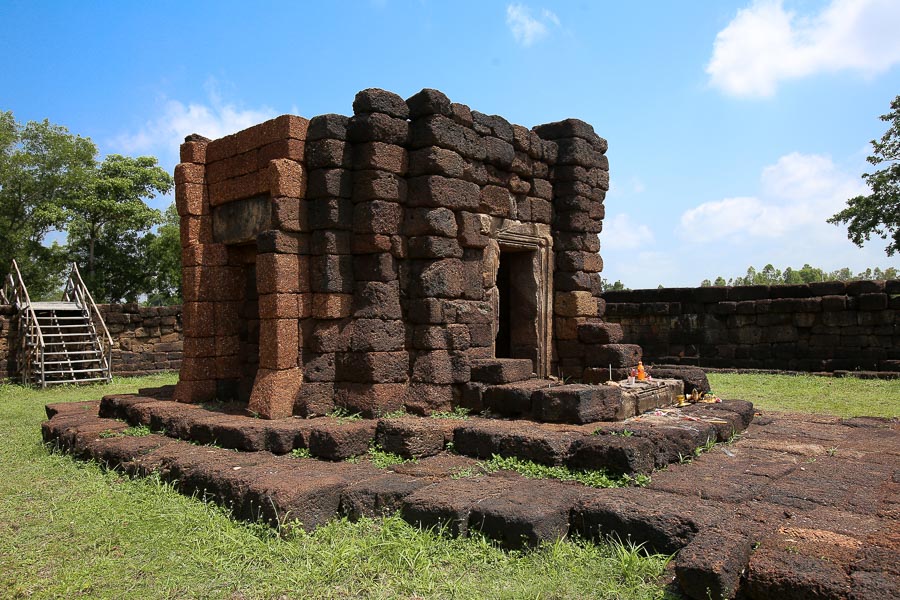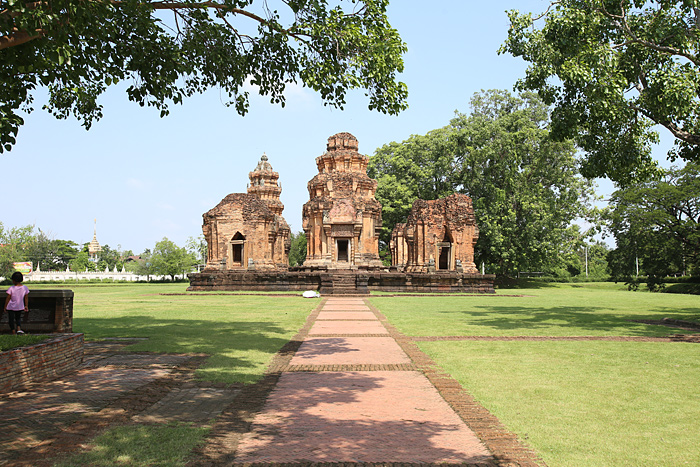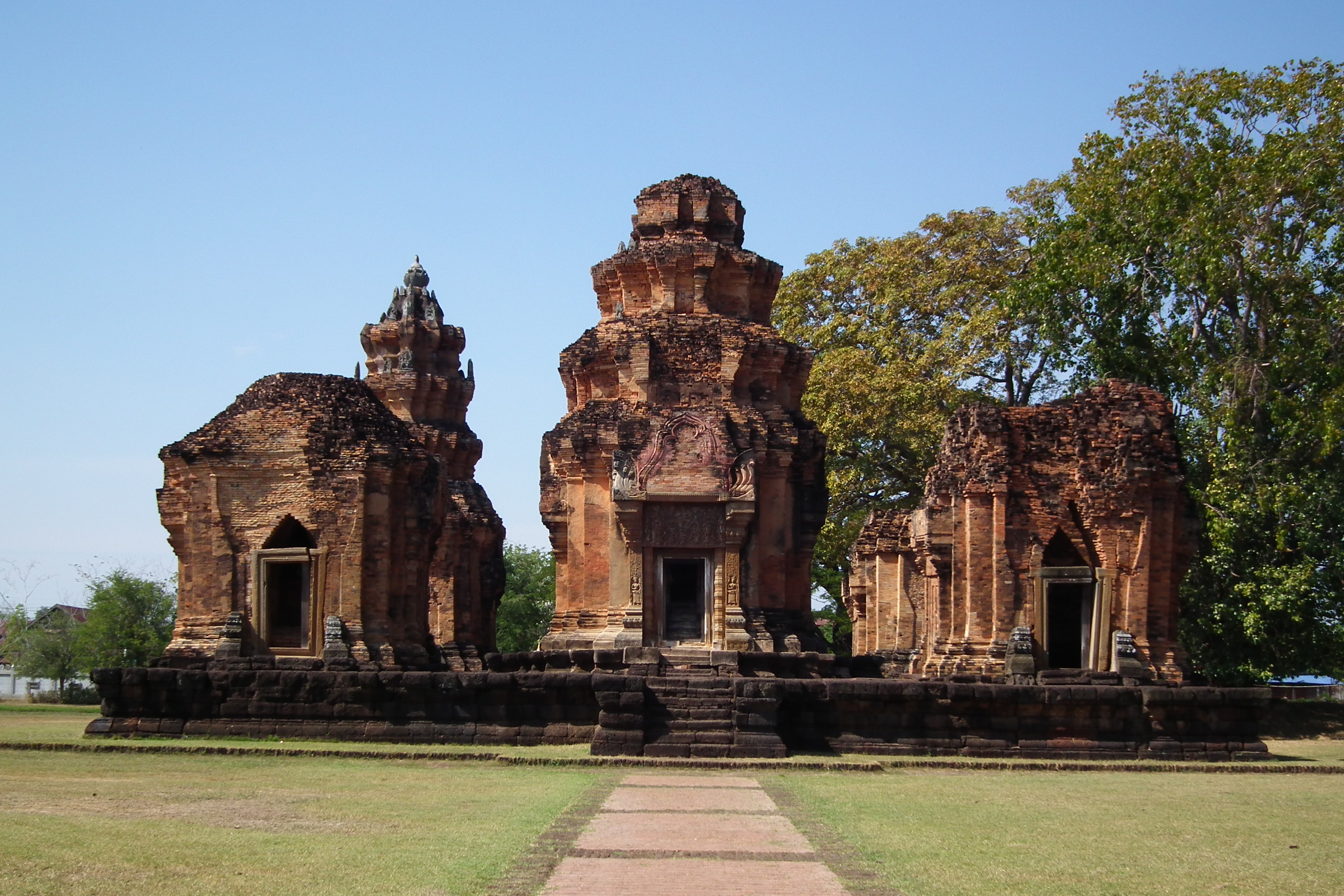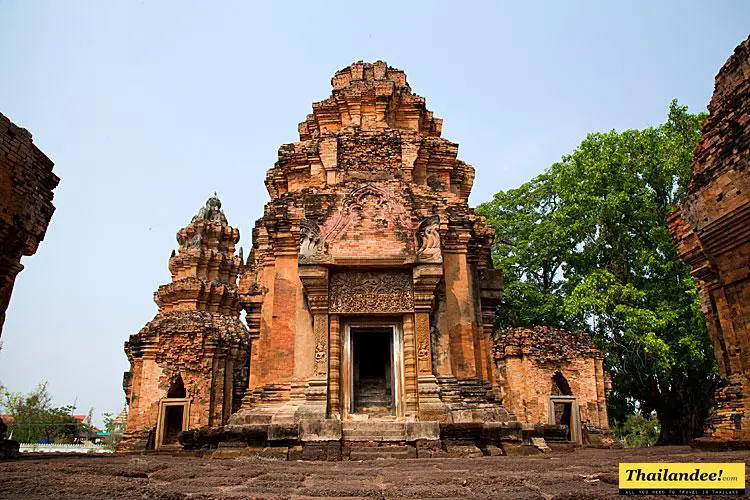Three Ancient Khmer Prasats East of Surin.
Continued from Part 16
 www.gt-rider.com
www.gt-rider.com
The magnificent success of the previous day's Surin Elephant Alms Giving ceremony certainly left me on a high.
I was overjoyed to witness this unique event.
A tropical storm was inbound from the East & forecast to hit Ubon in a day or two.
I don't fancy getting caught in a few days of heavy rain, and while I don't mind riding in the rain, taking photos and getting my phone or camera wet is not an option for me. Let's see how it goes leading East towards Ubon.
Three sets of ruins were earmarked for the day,
Prasat Muang Thi
Prasat Chang Pi
Prasat Sikhoraphum
Prasat Muang Thi

On R226, 23 km East of Surin, 400 metres North of the highway.

Located in the compound of Wat Chom Suthawat, these crumbling ruins need some TLC and more support.

In its present form, Prasat Muang Thi comprises three towers built in brick and mortar.

These were originally part of a group of five towers arranged in a quincunx shape (like the number 5 on a dice) sitting upon a single brick base.
This arrangement is rarely seen in Thailand—the sole exception is Prasat Sikhoraphum, located nearby—but was very common in Khmer architecture, including major monuments such as Pre Rup, East Mebon, and Angkor Wat.

According to the art historian Michael Freeman, the quincunx arrangement signifies Mount Meru and was generally reserved for state temples.
However, the towers at Muang Thi are too small to have been the centrepiece of state-sponsored temples, and there is no evidence of any other structures in the area (such as moats or enclosure walls) that would suggest the presence of a significant temple.
One possibility is that they were built by local leaders in the Khmer era or later, following the model of Prasat Sikhoraphum or other nearby temples that no longer exist.

According to a signpost on site, the towers were altered sometime near the end of the Ayutthaya era or in the early Rattanakosin periods (corresponding to the late 18th-early 19th centuries), suggesting that all five towers were still standing.
The remaining towers are structurally unsound and are bolstered by steel bracing added by the Fine Arts Department, presumably as a stopgap measuring pending a more thorough rehabilitation.

Prasat Muang Thi Location:

 maps.app.goo.gl
maps.app.goo.gl
Prasat Muang Thi Info Source:

 www.orientalarchitecture.com
www.orientalarchitecture.com
To be continued.
Continued from Part 16
Surin Elephant Tak Bat Buddhist alms ceremony for Lent.
Part 16 Chiang Khong - Lower Esarn Meander July 2024 Continued from https://www.gt-rider.com/se-asia-motorcycling/threads/chiang-khong-lower-esarn-meander-july-2024-part-15-buriram-surin.16361/ Holed up in Surin, killing time before I could get a room in Ubon because of the wax candle...
The magnificent success of the previous day's Surin Elephant Alms Giving ceremony certainly left me on a high.
I was overjoyed to witness this unique event.
A tropical storm was inbound from the East & forecast to hit Ubon in a day or two.
I don't fancy getting caught in a few days of heavy rain, and while I don't mind riding in the rain, taking photos and getting my phone or camera wet is not an option for me. Let's see how it goes leading East towards Ubon.
Three sets of ruins were earmarked for the day,
Prasat Muang Thi
Prasat Chang Pi
Prasat Sikhoraphum
Prasat Muang Thi
On R226, 23 km East of Surin, 400 metres North of the highway.
Located in the compound of Wat Chom Suthawat, these crumbling ruins need some TLC and more support.
In its present form, Prasat Muang Thi comprises three towers built in brick and mortar.
These were originally part of a group of five towers arranged in a quincunx shape (like the number 5 on a dice) sitting upon a single brick base.
This arrangement is rarely seen in Thailand—the sole exception is Prasat Sikhoraphum, located nearby—but was very common in Khmer architecture, including major monuments such as Pre Rup, East Mebon, and Angkor Wat.
According to the art historian Michael Freeman, the quincunx arrangement signifies Mount Meru and was generally reserved for state temples.
However, the towers at Muang Thi are too small to have been the centrepiece of state-sponsored temples, and there is no evidence of any other structures in the area (such as moats or enclosure walls) that would suggest the presence of a significant temple.
One possibility is that they were built by local leaders in the Khmer era or later, following the model of Prasat Sikhoraphum or other nearby temples that no longer exist.
According to a signpost on site, the towers were altered sometime near the end of the Ayutthaya era or in the early Rattanakosin periods (corresponding to the late 18th-early 19th centuries), suggesting that all five towers were still standing.
The remaining towers are structurally unsound and are bolstered by steel bracing added by the Fine Arts Department, presumably as a stopgap measuring pending a more thorough rehabilitation.
Prasat Muang Thi Location:
Prasat Mueang Tee · VMQ2+9P6 à¸à¸²à¸à¸«à¸¥à¸§à¸à¸à¸à¸à¸ สร à¹à¸¡à¸·à¸à¸à¸à¸µ Mueang Surin District, Surin 32000, Thailand
âââââ · Historical landmark
 maps.app.goo.gl
maps.app.goo.gl
Prasat Muang Thi Info Source:

Prasat Muang Thi, Surin, Thailand
Photos and description of the architecture of Prasat Muang Thi, a small set of brick towers in an unusual quincunx arrangement, dating from the 18th century or earlier.
To be continued.






